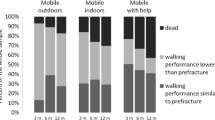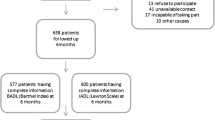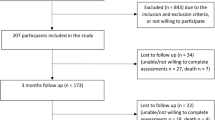Abstract
Summary
A score for identifying post-hip-fracture surgery patients at various levels (high, medium, and low) of risk for unsuccessful recovery of pre-fracture walking ability was developed. Three hundred ninety-eight HF patients were enrolled in the study. The score significantly and independently predicted failure to walk independently at discharge, failure to walk independently after 12 months, and death after 12 months. The score may be useful for clinicians and healthcare administrators to target populations for rehabilitative programs.
Introduction
To develop a model predicting at the time that elderly hip-fracture (HF) patients undergo rehabilitation if they will have recovered walking independence at discharge.
Methods
Data from all patients admitted to a Department of Rehabilitation in Italy between January 2001 and June 2008 after HF surgery were used. Variables concerning cognitive, clinical, functional, and social parameters were evaluated. Predominant measures were identified through correspondence analysis, and a variable score was defined. Three risk classes (minimum, moderate, and high) were identified and univariate and multivariate logistic regressions were used to assess the model's predictivity and risk classes for the various outcomes.
Results
Three hundred ninety-eight HF patients were enrolled. The variables selected to construct the score were age, gender, body mass index, number of drugs being taken, the Mini Mental State Examination, the Instrumental Activity of Daily Living, and the pre-fracture Barthel index. According to univariate analysis, the score was not better than the pre-fracture Barthel's index, but, according to multivariate analysis, it was an independent predictor for all the outcomes, while the pre-fracture Barthel index predicted only outcomes at discharge. In particular, the score significantly predicted failure to walk independently at discharge, failure to walk independently after 12 months, and death after 12 months.
Conclusions
A method of identifying post-HF surgery patients at various levels (high-, medium-, and low-) of risk for unsuccessful recovery of pre-fracture walking ability has been designed. The method may be useful for clinicians and healthcare administrators to target populations for rehabilitative programs.





Similar content being viewed by others
References
Brauer CA, Coca-Perraillon M, Cutler DM, Rosen AB (2009) Incidence and mortality of hip fractures in the United States. JAMA 302:1573–1579
Giversen IM (2006) Time trends of age-adjusted incidence rates of first hip fractures: a register-based study among older people in Viborg County, Denmark, 1987–1997. Osteoporos Int 17:552–564
Melton LJ III, Kearns AE, Atkinson EJ, Bolander ME, Achenbach SJ, Huddleston JM, Therneau TM, Leibson CL (2009) Secular trends in hip fracture incidence and recurrence. Osteoporos Int 20:687–694
White SM, Griffiths R (2010) Projected incidence of proximal femoral fracture in England: A report from the NHS Hip Fracture Anaesthesia Network (HIPFAN). Injury (in press)
Holt G, Smith R, Duncan K, Hutchison JD, Reid D (2009) Changes in population demographics and the future incidence of hip fracture. Injury 40:722–726
Boonen S, Autier P, Barette M, Vanderschueren D, Lips P, Haentjens P (2004) Functional outcome and quality of life following hip fracture in elderly women: a prospective controlled study. Osteoporos Int 15:87–94
Holt G, Smith R, Duncan K, Hutchison JD, Gregori A (2008) Outcome after surgery for the treatment of hip fracture in the extremely elderly. J Bone Joint Surg Am 90:1899–1905
Maggi S, Siviero P, Wetle T, Besdine RW, Saugo M, Crepaldi G (2010) A multicenter survey on profile of care for hip fracture: predictors of mortality and disability. Osteoporos Int 21:223–231
Young Y, Fried LP, Kuo YH (2010) Hip fractures among elderly women: longitudinal comparison of physiological function changes and health care utilization. J Am Med Dir Assoc 11:100–105
Kristensen MT (2011) Factors affecting functional prognosis of patients with hip fracture. Eur J Phys Rehabil Med 47:257–264
Bellelli G, Magnifico F, Trabucchi M (2008) Outcomes at 12 months in a population of elderly patients discharged from a rehabilitation unit. J Am Med Dir Assoc 9:55–64
Matthews LE (1985) Using anthropometric parameters to evaluate nutritional status. J Nutr Elderly 5(2):67–71
Charlson ME, Pompei P, Ales KL, MacKenzie CR (1987) A new method of classifying prognostic comorbidity in longitudinal studies: development and validation. J Chronic Dis 40:373–383
Shah S, Vanclay F, Cooper B (1989) Improving the sensitivity of the Barthel Index for stroke rehabilitation. J Clin Epidemiol 42:703–709
Granger CV, Cotter AC, Hamilton BB, Fiedler RC (1993) Functional assessment scales: a study of persons after stroke. Arch Phys Med Rehabil 74:133–138
Tinetti ME (1986) Performance-oriented assessment of mobility problems in elderly patients. J Am Geriatr Soc 34:119–126
Franchignoni FP, Tesio L, Ricupero C, Martino MT (1997) Trunk control test as an early predictor of stroke rehabilitation outcome. Stroke 28:1382–1385
Lawton MP, Brody EM (1969) Assessment of older people: self-maintaining and instrumental activities of daily living. Gerontologist 9:179–186
Folstein MF, Folstein SE, McHugh PR (1975) “Mini-mental state”. A practical method for grading the cognitive state of patients for the clinician. J Psychiatr Res 12:189–198
Sheikh JI, Yesavage JA (1986) Geriatric Depression Scale (GDS): recent evidence and development of a shorter version. Clinical gerontology: a guide to assessment and intervention. The Haworth Press, NY, pp 165–173
Sourial N, Wolfson C, Zhu B, Quail J, Fletcher J, Karunananthan S, Bandeen-Roche K, Beland F, Bergman H (2010) Correspondence analysis is a useful tool to uncover the relationships among categorical variables. J Clin Epidemiol 63:638–646
Koval KJ, Skovron ML, Aharonoff GB, Meadows SE, Zuckerman JD (1995) Ambulatory ability after hip fracture. A prospective study in geriatric patients Clin Orthop Relat Res 310:150–159
Lieberman D, Fried V, Castel H, Weitzmann S, Lowenthal MN, Galinsky D (1996) Factors related to successful rehabilitation after hip fracture: a case–control study. Disabil Rehabil 18:224–230
Lefaivre KA, Macadam SA, Davidson DJ, Gandhi R, Chan H, Broekhuyse HM (2009) Length of stay, mortality, morbidity and delay to surgery in hip fractures. J Bone Joint Surg Br 91:922–927
Haentjens P, Autier P, Barette M, Venken K, Vanderschueren D, Boonen S (2007) Survival and functional outcome according to hip fracture type: a one-year prospective cohort study in elderly women with an intertrochanteric or femoral neck fracture. Bone 41:958–964
Morrison RS, Magaziner J, McLaughlin MA, Orosz G, Silberzweig SB, Koval KJ, Siu AL (2003) The impact of post-operative pain on outcomes following hip fracture. Pain 103:303–311
Carson JL, Duff A, Poses RM, Berlin JA, Spence RK, Trout R, Noveck H, Strom BL (1996) Effect of anaemia and cardiovascular disease on surgical mortality and morbidity. Lancet 348:1055–1060
Young Y, Xiong K, Pruzek RM (2011) Longitudinal functional recovery after post-acute rehabilitation in older hip fracture patients: the role of cognitive impairment and implications for long-term care. J Am Med Dir Assoc 12:431–438
Beloosesky Y, Weiss A, Grinblat J, Brill S, Hershkovitz A (2004) Can functional status, after rehabilitation, independently predict long-term mortality of hip-fractured elderly patients? Aging Clin Exp Res 16:44–48
Parker MJ, Palmer CR (1995) Prediction of rehabilitation after hip fracture. Age Ageing 24:96–98
Siu AL, Penrod JD, Boockvar KS, Koval K, Strauss E, Morrison RS (2006) Early ambulation after hip fracture: effects on function and mortality. Arch Intern Med 166:766–771
Torpilliesi T, Bellelli G, Morghen S, Gentile S, Ricci E, Turco R, Trabucchi M (2011) Outcomes of nonagenarian patients after rehabilitation following hip fracture surgery. J Am Med Dir Assoc (in press)
Hagino T, Ochiai S, Wako M, Sato E, Maekawa S, Senga S, Sugiyama H, Hamada Y (2007) A simple scoring system to predict ambulation prognosis after hip fracture in the elderly. Arch Orthop Trauma Surg 127:603–606
Masuda T, Miura N, Ishii S, Hibino Y, Beppu M (2004) New preoperative evaluation system of the physical findings of aged patients with femoral neck fracture. J Orthop Sci 9:434–439
Wallace RG, Lowry JH, McLeod NW, Mollan RA (1986) A simple grading system to guide the prognosis after hip fracture in the elderly. Br Med J (Clin Res Ed) 293:665
Hashmi MA, Tellisi N, Rigby AS, Wahab KH (2004) The value of a prognostic scoring system in the rehabilitation of elderly patients with proximal femoral fractures. Int J Clin Pract 58:2–5
Marottoli RA, Berkman LF, Cooney LM Jr (1992) Decline in physical function following hip fracture. J Am Geriatr Soc 40:861–866
Osnes EK, Lofthus CM, Meyer HE, Falch JA, Nordsletten L, Cappelen I, Kristiansen IS (2004) Consequences of hip fracture on activities of daily life and residential needs. Osteoporos Int 15:567–574
Shyu YI, Chen MC, Liang J, Wu CC, Su JY (2004) Predictors of functional recovery for hip fractured elders during 12 months following hospital discharge: a prospective study on a Taiwanese sample. Osteoporos Int 15:475–482
Acknowledgments
The authors wish to thank Dr. Sara Morghen for the management of database and Drs. Tiziana Torpilliesi, Alessandra Marrè, Eleonora Ricci Elena Lucchi, and Salvatore Speciale for collecting data. Sincere appreciation is due to the team of physical therapists for their support in rehabilitation activities and to Linda Inverso Moretti for reviewing the English version of this manuscript.
Conflicts of interest
None.
Author information
Authors and Affiliations
Corresponding author
Rights and permissions
About this article
Cite this article
Bellelli, G., Noale, M., Guerini, F. et al. A prognostic model predicting recovery of walking independence of elderly patients after hip-fracture surgery. An experiment in a rehabilitation unit in Northern Italy. Osteoporos Int 23, 2189–2200 (2012). https://doi.org/10.1007/s00198-011-1849-x
Received:
Accepted:
Published:
Issue Date:
DOI: https://doi.org/10.1007/s00198-011-1849-x




